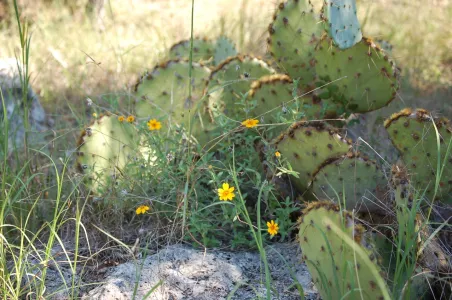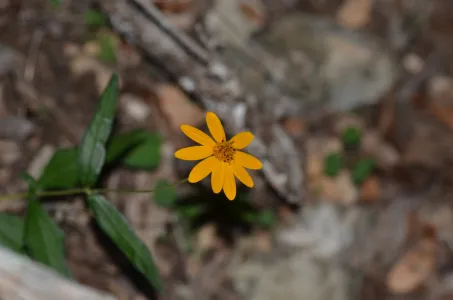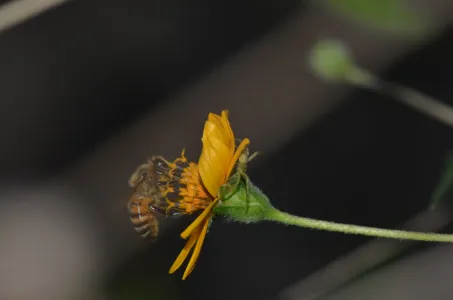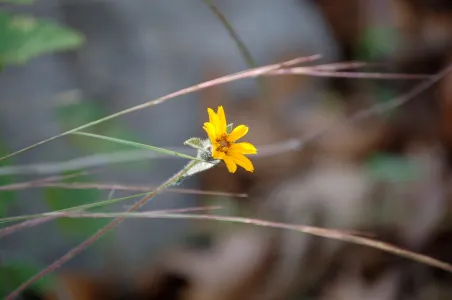Delmar Cain
The beginning of November sometimes gives us cooler weather but it always reminds us that Thanksgiving is right around the corner and that the year is moving swiftly toward a new year. We can still enjoy the browns, grays and yellows of the fall grasses and flowers and look forward to the colorful foliage that will soon follow. Even so it is not too soon to ponder for next year another Plant of the Month in the NICE (Natives Instead of Common Exotics) Program from the Boerne Chapter of the Native Plant Society of Texas (NPSOT).

Watching the Hill Country struggle through several months of severe drought, the Boerne Chapter chose “Survivors of 2011” as a theme for its NICE program for 2012. (Anyone confused by my prematurely announcing the beginning of a new NICE year in the Native Grown article, published on 9/17/2012, is hereby granted one GOTCHA. My friend, Wilt Shaw, mistakenly thinks that if he gets enough GOTCHAs, he can exchange them for one cup of coffee on Coffee Tuesday at the Bear Moon Bakery). Survivor plants are those that not only lived but also seemed to thrive during extended months of dry, hot weather. Zexmenia (Wedelia texana), the Plant of the Month for November should always be among the first chosen for a list of survivors.
Zexmenia is a native perennial (lives more than two years) herb in the Aster family. It is found in the southwestern part of Texas, including the Edwards Plateau and south to Corpus Christi and the Rio Grande Valley, the Trans-Pecos, and into Mexico. Since the annual rainfall diminishes from east to west in this region, a plant that can grow over this geographical area is not likely to be affected by a dry year. A wet year might be more of a problem, except that zexmenia has also been found growing as far east as Madison County, which is east of Bryan.

Zexmenia has several common names including orange zexmenia, wedelia, hairy wedelia and Texas creeping-oxeye. It also has several scientific names (called synonyms) including Zexmenia hispida, Wedelia hispida and Wedelia acapuscensis var. hispida. The genus Wedelia, containing a group of plants called creeping oxeyes, honors Goerg Wolfgang Wedel, an 18th Century professor of botany and other sciences. “Hispida” in the scientific names refers to the hairy or bristly surface of the stems and leaves.
The plant is actually a small shrub whose lower stem becomes woody with age. Its recent growth and leaves are herbaceous, meaning that they are lacking in woody tissue. A characteristic that does not go unnoticed is that the upper leaves and stems and even the woody stems have stiff hairs that are rough, almost like sandpaper. Hairy wedelia is the Esau of the Wedelia genus and is noted as such in most of its synonyms.

Wedelia grows in most soils including sand, caliche, clay, loam and limestone so long as it is well drained. It can grow in sun and also in part shade. It will not spread rapidly but it is long-lived and easy to grow. It generally will not die with more water but it may grow longer stems with fewer leaves and blooms. Some pruning may increase the blooms.
In the southern part of its range zexmenia is evergreen. Farther north it will die back with the colder temperatures. In our area it should be evergreen, but its location in your yard may affect its behavior. Its leaves, rough on top and underneath, vary from being lobed (small rounded or pointed projection on one or each side) to unlobed. The leaf edges are either indented or smooth. The plants may range up to 3 feet in height.

Although it has attractive grayish to green foliage, the blooming period and the blooms are the attractive landscaping features of hairy wedelia. The inch wide yellow-orange flowers arise on long stems above the foliage. Seven to fifteen petals surround the showy disk flowers in the center. The blooms, which arrive in late spring, will continue until November. It is a host plant for the bordered patch butterfly.
We found zexmenia growing natively at several locations around our lot. Although it may be found in flat areas near prickly pear, it also grows on rocky slopes. Some sources indicate that deer will browse zexmenia. Browsing has not been a problem at our house. Maybe we have an especially hairy group of zexmenia.
This versatile and hardy perennial will make a good addition in any landscape. It is presently available for sale at Medina Garden Nursery, 13417 State Highway 16-N in Medina (830-589-2771). For planting and care instructions check out the Boerne NPSOT website: http://www.npsot.org/wp/boerne/
